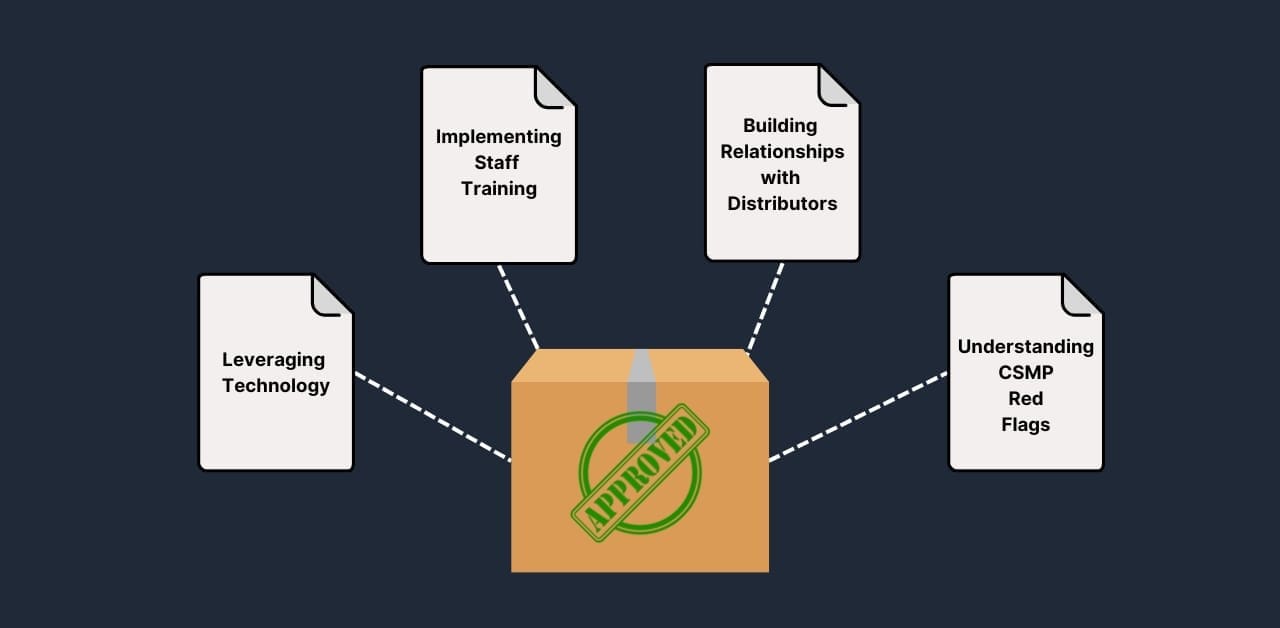Retail pharmacists are essential in dispensing crucial medications but also bear the heavy responsibility of preventing drug diversion. The Controlled Substance Monitoring Program (CSMP) is vital in this effort, and understanding its regulations can be the key to smooth operations and avoiding legal complications. A major component of CSMP regulations is suspicious order reporting.
This installment of the CSMP blog series explores suspicious order reporting, the challenges it presents for both distributors and retail pharmacies, and how technology and training can empower pharmacies to overcome these obstacles.
What is Suspicious Order Reporting?
In the context of the CSMP, suspicious orders are controlled substance orders that raise red flags due to their potential link to diversion. Although criteria for defining a suspicious order can vary, they often involve exceeding predetermined thresholds set by distributors. These thresholds, as discussed in part V of our CSMP blog series, limit the quantity of controlled substances a pharmacy can order within a specific timeframe. Understanding how the CSMP defines suspicious orders helps to understand its implications for both distributors and customers.
Suspicious Order Reporting Requirements for Distributors
The CSMP outlines stringent reporting requirements for distributors, compelling them to report suspicious orders to the relevant authorities. These reports are crucial for timely intervention and diversion prevention. The following sections highlight five Key suspicious order reporting requirements for distributors.
1. Mandatory Reporting:
Distributors are obligated to report all suspicious orders, including those flagged by their internal systems and those exceeding established thresholds. They cannot ship an order they’ve identified as suspicious.
2. State-Level Reporting:
Suspicious order reports must be submitted by the distributor to the relevant “settling states,” which refers to states involved in legal settlements related to controlled substance diversion. This reporting obligation also extends to states that do not have their own mandatory reporting requirements.
3. Quarterly Summary Reports:
Distributors are required to submit quarterly reports to settling states that opt to receive them. These reports provide an overview of suspicious orders from the top ten customers for each highly diverted controlled substance. The report includes data points such as the number of suspicious reports submitted for each customer, order volume, order frequency, and the ratio of controlled substance orders to total pharmaceutical orders.
4. Other Reporting Requirements:
Suspicious order reporting requires comprehensive information about the suspicious order, such as customer details (name, address, DEA and state license numbers), order date, drug specifics (NDC number, quantity), a clear explanation of why the order is deemed suspicious, and contact information for a knowledgeable representative from the distributor’s CSMP department.
5. Standardized Electronic Format:
Suspicious order reports must adhere to a uniform electronic format across all settling states, ensuring consistency and facilitating data analysis.
CSMP Regulations: Order Complications and Inventory Scrutiny
CSMP regulations not only shapes the suspicious order reporting process for distributors but also has a significant impact on retail pharmacies. While primarily governing controlled substances for distributors, it carries indirect implications that pharmacists and staff must understand to ensure compliance and avoid workflow disruptions. Challenges related to suspicious order reporting can result in delayed or canceled orders and heightened scrutiny surrounding inventory reports and data requests.
1. Delayed or Cancelled Orders:
Pharmacies may experience delays in receiving controlled substance orders since they cannot be sent out by distributors until all suspicious activity is resolved. This also impacts retail pharmacies that have not been flagged for suspicion since distributors are now busy evaluating orders that meet suspicious criteria and requesting additional inquiries or documentation from all customers.
2. Increased Scrutiny of Inventory Records:
Meticulous record-keeping becomes even more critical under CSMP regulations. Pharmacies must maintain detailed and accurate records of all controlled substance transactions, including inventory tracking, dispensing, and destruction. These records may be requested by distributors or regulatory authorities during investigations triggered through suspicious order reporting.
Addressing Reporting Challenges with Technology and Training
The implementation of new suspicious order reporting requirements for distributors can indirectly pose challenges for retail pharmacies already grappling with limited resources and time constraints. However, proper technology, training, communication, and understanding can help those struggling comply with CSMP regulations.
1. Leveraging Technology:
Advanced pharmacy management systems and dedicated controlled substance inventory management tools can streamline record-keeping, automate reporting, and identify potential red flags before they escalate. These systems provide a centralized platform for managing controlled substances, ensuring accuracy, and improving efficiency.
2. Implementing Staff Training:
Comprehensive training for all pharmacy staff on CSMP regulations, including suspicious order reporting procedures and red flag identification, is essential. Well-informed staff are better equipped to handle controlled substance transactions, maintain compliant records, and communicate effectively with distributors, minimizing the risk of triggering unnecessary suspicion.
3. Building a Relationship with Distributors:
Pharmacies should foster open communication with their distributors regarding potential increases in controlled substance orders. Providing clear justifications for larger orders can help prevent delays caused by unnecessary suspicion. For example, a pharmacy experiencing a surge in legitimate prescriptions due to a virus outbreak might proactively inform their distributor to avoid triggering a suspicious order alert.
4. Understanding CSMP Red Flags:
Pharmacies need to familiarize themselves with common CSMP red flags that can lead to an order being flagged as suspicious. These red flags can range from disproportionately high orders of controlled substances to unusual ordering patterns and cash payments. Awareness of these red flags allows pharmacies to self-assess their practices and mitigate potential issues proactively.
Conclusion
The suspicious order reporting component of the CSMP represents a significant shift in controlled substance oversight, emphasizing proactive monitoring and reporting for both retail pharmacies and distributors. By understanding CSMP regulations, embracing technology solutions, prioritizing staff training, communicating with distributors, and understanding red flags, retail pharmacies can adapt to these changes, ensuring compliance and contributing to the collective effort to combat drug diversion.


